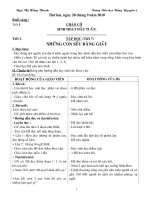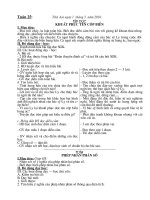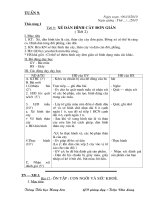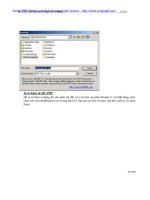- Trang chủ >>
- Mầm non - Tiểu học >>
- Lớp 5
5 4 2 feel, think, move (life science) TG
Bạn đang xem bản rút gọn của tài liệu. Xem và tải ngay bản đầy đủ của tài liệu tại đây (115.27 KB, 4 trang )
5.4.2
Feel, Think, Move
This is an informational article
about how the brain communicates with the
musculoskeletal system to enable you to
move. It explains how people grow, how people move, and what happens when they need
to learn how to move again.
SUMMARY
LESSON VOCABULARY
abdomen
coordination
neurons
therapists
cerebral hemispheres
musculoskeletal
organ
INTRODUCE THE BOOK
Discuss with
students the title and the author of Feel,
Think, Move. Based on the title, ask students
what kind of information they think this book
will provide. Have students study the cover
photo. Ask: “What do the words feel, think,
and move have to do with the action in the
photograph?”
INTRODUCE THE TITLE AND AUTHOR
BUILD BACKGROUND Discuss
bones, muscles,
and the brain with students. Without getting
into the text, find out how much students know
about the subject. Ask: What enables you to
play on the playground or play sports? What
could make you a better athlete and why?
PREVIEW/USE TEXT FEATURES Have
students
scan the book and look at the illustrations. Ask:
What do you think you are about to learn from
reading this book? Look together at the illustration on page 6, and ask: What do you already
know about the brain from this illustration? On
page 8, ask: What do you already know about
how your body works when playing baseball?
GENERALIZE
PREDICT
READ THE BOOK
SET PURPOSE Have
students scan chapter heads
and illustrations in the book. Then, have them
set a purpose for reading this article.
Remind students
that to predict means to tell what you think
might happen next in a story based on what
has already happened. Have students make
three columns on a piece of paper, labeled
“predict,” “justify,” and “confirm.” Then, have
them write down a prediction at the beginning of each chapter, and the justification that
supports their prediction. Then, at the end of
each chapter, they should confirm or refine
their prediction. They should have 10 predictions, justifications, and confirmations at the
end of the book.
STRATEGY SUPPORT: PREDICT
COMPREHENSION QUESTIONS
PAGE 13 What does it mean that muscles work
in opposing pairs? (It means that one muscle
contracts to bend a joint, and the other contracts to straighten it.)
What are two types of involuntary
muscles, and what makes them “involuntary”?
(smooth and cardiac; they work without having
to think about it.)
PAGES 12–13
PAGE 15 Why is a healthy 15-year-old a better
athlete than a healthy 5-year-old, besides the
fact that the 15-year-old is bigger? (The 15year-old has better motor skills.)
PAGES 16–17 Support this generalization:
On average, women are shorter than men.
(Possible responses: because boys grow for
longer than girls, because boys grow more per
year during their growth spurt.)
PAGE 18 Why does practice make Lisa Leslie
a great athlete? (Possible response: Practice
improves her motor skills.)
76
Feel, Think, Move
16924_LRD_TG_076-077 76
10/20/05 2:40:33 PM
REVISIT THE BOOK
READER RESPONSE
1. Boys’ growth spurts are (on average) six
years longer than those of girls.
2. Occipital—You see the ball with your eyes.
Temporal—You recall how to kick the ball.
Frontal—The brain tells your legs to move.
3. Cardiac means having to do with the heart.
“Heart” is the word it is related to, also
cardiovascular, cardiology, and electrocardiogram.
4. An athlete’s treatment might focus on ankle
sprains or pulled tendons, while an older
person’s therapy might center on recovery
from joint replacement surgery.
Discuss the text features with students. Point out how much they
can learn about the subject in the reader
before they even begin reading. Write a list
of terms on the board that students can get
from the captions and illustrations. Ask: What
else do you want to know about each of these
terms? Can you properly define the terms
now, or do you need to know more?
EXTEND UNDERSTANDING
RESPONSE OPTIONS
Have students write a description of
a day at a physical therapist’s appointment.
Have them describe what other people are
there for and what exercises they are doing for
specific body parts or problems.
WRITING
SCIENCE CONNECTION
Have students research diseases that affect people’s motor
skills. They should identify the
cause of the disease, the effects of the
disease, and the cure or treatment of the
disease. They should also describe how
people with each disease cope with their
disabilities and how the world
accommodates disabilities.
Skill Work
TEACH/REVIEW VOCABULARY
Review vocabulary words with students.
Have students turn to page 20 and study
the photo. Have them describe the events in
the photo using the vocabulary words.
TARGET SKILL AND STRATEGY
A generalization is a broad
statement or rule that applies to many
examples. There are faulty and valid generalizations. Ask students to identify the faulty
generalization: “Men are always better athletes than women,” and “In general, men are
taller than women.” Have students explain
why the first statement is faulty (Mia Hamm
is a better soccer player than most men;
Lisa Leslie is a better basketball player than
most men) and why the second statement
is valid (average heights of men and women
prove that this is true, in general).
GENERALIZE
Explain the term generalization to
students. Point out clue words (always, in
general, and usually). Have students give
equivalent words in their home language.
Then, have them state faulty and valid generalizations and support or discredit each
using their new clue words in English.
PREDICT To predict means to tell what you
think might happen next in a story based on
what has already happened. Scan the book,
looking at the chapter heads and illustrations. Ask: Why do you think the author has
organized this information in this way? Elicit
from them that learning about the brain first
will help them understand and predict how
the musculoskeletal system works.
ADDITIONAL SKILL INSTRUCTION
COMPARE AND CONTRAST Have students
compare the motor skills at various stages
of development, from babies to toddlers to
adolescents to adults to the elderly. Have
them write down the differences between
each progressive stage.
Feel, Think, Move
16924_LRD_TG_076-077 77
77
10/20/05 2:40:34 PM
Feel, Think, Move
Name
Generalize
A generalization is made after thinking about a number of examples or facts and identifying what
they have in common.
Directions Reread the following passage from Feel, Think, Move.
Physical therapists use a wide range of treatments, and they treat all types of people—old,
young, fit, inactive. Sometimes they have patients exercise to increase flexibility or strength.
Other times they use heat or cold to reduce pain. And sometimes they massage muscles to
increase blood circulation.
1–4. Use the information in the passage to complete the graphic organizer.
Generalization
© Pearson Education 5
Supporting Facts
5. Now write a different generalization you can make from reading Feel, Think, Move.
78
16924_LRD_TG_078-079 1
10/20/05 2:41:32 PM
Feel, Think, Move
Name
Vocabulary
Directions Write the vocabulary word that matches the definition.
Check the Words You Know
© Pearson Education 5
abdomen
coordination
neurons
therapists
cerebral hemispheres
musculoskeletal
organ
1.
muscles working together smoothly for efficient movement
2.
main cells of the nervous system
3.
the section of the body that holds the intestines and stomach; the belly
4.
an internal part of the body that perfoms a specific function
5.
having to do with the system that includes the muscles and
the skeleton
6.
left and right halves of the brain that control the opposite sides
of the body
7.
specialists who provide treatment or healing of an illness or disability
Directions Write a short paragraph about how the body works to make itself move.
Use at least three vocabulary words.
79
16924_LRD_TG_078-079 79
3/20/06 8:46:55 AM









